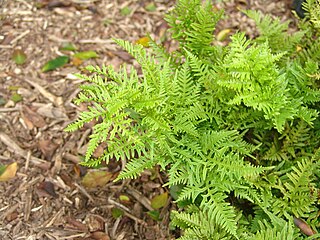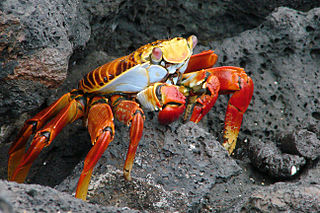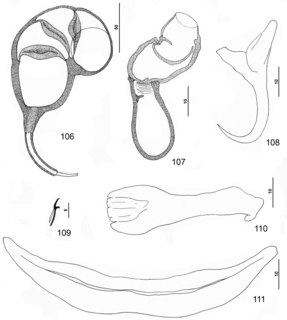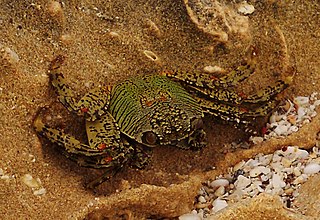
The Saint Peter and Saint Paul Archipelago is a group of 15 small islets and rocks in the central equatorial Atlantic Ocean. It lies in the Intertropical Convergence Zone, a region of the Atlantic characterized by low average winds punctuated with local thunderstorms. It lies approximately 510 nmi from the nearest point of mainland South America ; 625 km (388 mi) northeast of the archipelago of Fernando de Noronha; 990 km (620 mi) from the city of Natal; and 1,824 km (1,133 mi) from the west coast of Africa. Administratively, the archipelago belongs to Brazil and is part of the special "state district" of Fernando de Noronha, in the state of Pernambuco, in spite of the very large distance between the two island groups and the even larger distance to the state mainland.

Holocentridae is a family of ray-finned fish, the only family of the order Holocentriformes. The members of the subfamily Holocentrinae are typically known as squirrelfish, while the members of Myripristinae typically are known as soldierfish. In Hawaii, they are known by the Japanese name mempachi/menpachi (メンパチ) or the Hawaiian ʻūʻū.

Floreana Island is an island of the Galápagos Islands. It was named after Juan José Flores, the first president of Ecuador, during whose administration the government of Ecuador took possession of the archipelago. It was previously called Charles Island, and Santa María after one of the caravels of Columbus.

Grapsus grapsus is one of the most common crabs along the western coast of the Americas. It is known as the red rock crab, or, along with crabs such as Percnon gibbesi, as the Sally Lightfoot crab.
Saint Helena, Ascension Island and Tristan da Cunha, as well the other uninhabited islands nearby, are a haven for wildlife in the middle of the Atlantic Ocean. The islands are or were home to much endemic flora and fauna, especially invertebrates, and many endemic fish species found in the reef ecosystems off the islands. The islands have been identified by BirdLife International as Important Bird Areas for both their endemic landbirds and breeding seabirds.

Oldenlandia adscensionis was a species of plant in the family Rubiaceae. It was endemic to Ascension Island. It became extinct due to habitat loss.

Pteris adscensionis is a fern species in the subfamily Pteridoideae of the family Pteridaceae. It is endemic to Ascension Island, and there are thought to be fewer than 500 individuals left in the wild. Its natural habitat has been severely reduced due to the large number of species introduced to the island when it was first settled in the 18th century.

The Ascension scrub and grasslands ecoregion covers the dormant volcano, Ascension Island in the Atlantic Ocean. As well as shrubs and grasses wildlife on the island includes a range of unique flora and fauna. In particular the surrounding islets are important havens for many seabirds, although the seabird populations on Ascension island itself have been severely affected by introduced species, particularly cats.

Percnon gibbesi is a species of crab. It is one of at least two species commonly called "Sally Lightfoot", and is also referred to as the nimble spray crab or urchin crab. It has been described as "the most invasive decapod species to enter the Mediterranean".
Sally Lightfoot may refer to:

Grapsus is a genus of lightfoot crabs, comprising the following species:
Tortuga Bay is located on the Santa Cruz Island, about a 20-minute water-taxi ride from the main water taxi dock in Puerto Ayora. There is also a walking path, which is 1.55 miles (2,490 m) and is open from six in the morning to six in the evening. Visitors must sign in and out at the start of the path with the Galapagos Park Service office. Tortuga Bay has a gigantic, perfectly preserved beach that is forbidden to swimmers and is preserved for the wildlife where many marine iguanas, galapagos crabs and birds are seen dotted along the volcanic rocks. There is a separate cove where you can swim where it is common to view white tip reef sharks swimming in groups and on occasion tiger sharks

Holocentrus is a genus of squirrelfishes found in the Atlantic Ocean.

Sargocentron spiniferum, common name sabre squirrelfish, giant squirrelfish and spiny squirrelfish, is a large Indo-Pacific species of squirrelfish belonging to the family Holocentridae.

Holocentrus adscensionis is a squirrelfish of the family Holocentridae found in the Atlantic Ocean. Its range extends from North Carolina, USA to Brazil and throughout the Caribbean Sea in the Western Atlantic and from Gabon to Ascension Island in the Eastern Atlantic. It generally stays between 8 and 30 metres below the surface, but can be found at the surface or as deep as 180 metres (590 ft). It can reach up to 61 centimetres (24 in) TL in length, although it is more common for individuals to be around 25.0 centimetres (9.8 in) TL.

Pseudorhabdosynochus monaensis is a diplectanid monogenean parasitic on the gills of the rock hind, Epinephelus adscensionis. It has been described by Dyer, Williams & Bunkley-Williams in 1994 and redescribed by Kritsky, Bakenhaster and Adams in 2015.

Grapsus albolineatus is a species of decapod crustacean in the family Grapsidae, native to the Indo-Pacific.

Grapsus tenuicrustatus, commonly known as thin-shelled rock crab or Natal lightfoot crab, is a species of decapod crustacean in the family Grapsidae.

Grapsus longitarsis is a species of decapod crustacean in the family Grapsidae, native to the Indo-Pacific. It was first described by James Dwight Dana in 1851, from a specimen found in the Tuamotu Archipeligo, French Polynesia.















